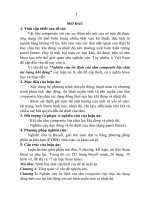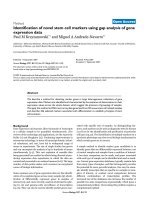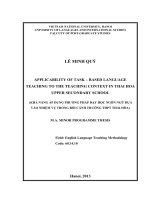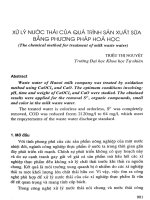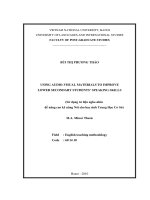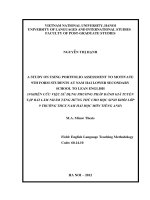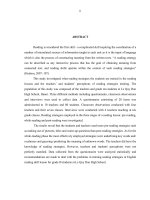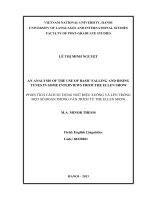BUCKLING OF CYLINDRICAL INFLATABLE COMPOSITE BEAMS USING ISOGEOMETRIC ANALYSIS mất ổn ĐỊNH của dầm hơi HÌNH TRỤ sử DỤNG PHƯƠNG PHÁP ĐẲNG HÌNH học
Bạn đang xem bản rút gọn của tài liệu. Xem và tải ngay bản đầy đủ của tài liệu tại đây (245.24 KB, 6 trang )
Kỷ yếu hội nghị khoa học và công nghệ toàn quốc về cơ khí - Lần thứ IV
BUCKLING OF CYLINDRICAL INFLATABLE COMPOSITE BEAMS USING
ISOGEOMETRIC ANALYSIS
MẤT ỔN ĐỊNH CỦA DẦM HƠI HÌNH TRỤ SỬ DỤNG PHƯƠNG PHÁP
ĐẲNG HÌNH HỌC
Thu Phan-Thi-Dang1a, Tuan Le-Manh1b, Giang Le-Hieu2c, Truong Nguyen-Thanh3,4d
1
Faculty of Mechanical Engineering, Ho Chi Minh City Vocational College
2
HCMC University of Technology and Education
3
Industrial Maintenance Training Center (IMTC),
4
Ho Chi Minh City University of Technology (HCMUT)
a
;
c
;
ABSTRACT
In this work, stability of Timoshenko cylindrical inflatable composite beams is
investigated based on isogeometric analysis (IGA). Linear term of Green-Lagrange strain
tensor is employed in considering linear eigen buckling analysis of the beam. Finite element
mesh in C1 continuity is obtained by using quadratic NURBS (Non-Uniform Rational BSpline) elements. Numerical model of a cantilever inflatable beam subjected to different
inflation pressures is constructed to derive corresponding critical loads. Convergence test
illustrates the advantages of the approach over the previous theories based on standard finite
element methods.
Keywords: inflatable composite beam, linear eigen buckling, isogeometric analysis
TÓM TẮT
Trong bài báo này, ổn định của dầm composite Timoshenko bơm khí hình trụ được
nghiên cứu dựa trên phương pháp giải tích đẳng hình học. Thành phần tuyến tính của tensor
biến dạng Green-Lagrange được sử dụng để xem xét phân tích bài toán mất ổn định trị riêng
tuyến tính. Lưới phần tử hữu hạn đạt liên tục C1 do sử dụng phần tử NURBS bậc hai. Mô hình
số của dầm hơi một đầu ngàm một đầu tự do, dưới áp lực bơm khí khác nhau được xây dựng
để tìm tải tới hạn tương ứng. Phân tích kiểm tra hội tụ thể hiện những ưu điểm của phương
pháp so với các phương pháp phần tử hữu hạn truyền thống.
Từ khóa: dầm bơm khí, mất ổn định, giải tích đẳng hình học.
1. INTRODUCTION
In the recent decades, composite materials are extensively applied in industry varying
from large scale structures. Structural applications with inflatable beams or arches with
modern textile materials have been growing and requiring a great effort on theoretical
development. The theories of the orthotropic inflatable beams were presented [1-10]. Le van
and Wielgosz [2, 3] have proven that for highly inflated isotropic beams, a linear model is
sufficient to get the static and dynamic responses of these structures. Finite element analyses
of inflated fabric structures present a challenge in that both material and geometric on
linearities arise due to the nonlinear load/deflection behavior of the fabric (at low loads),
pressure stiffening of the inflated fabric, fabric-tofabric contact, and fabric wrinkling on the
structure surface. In addition to checking fabric loads, the finite element model is used to
predict the fundamental mode of the inflated fabric beam. In this paper, numerical model of
821
Kỷ yếu hội nghị khoa học và công nghệ toàn quốc về cơ khí - Lần thứ IV
cylindrical inflatable beam is developed in the isogeometric analysis framework. Quadratic
NURBS-based Timoshenko beam elements are employed in convergence test. The objective
is to extend the linear model. This paper uses all assumptions and development made in the
previous paper presented by Thanh-Truong Nguyen et al [4]. Furthermore, the inflation
pressure prestressing tensor is still assumed spheric and isotropic.
2. NURBS-BASED ISOGEOMETRIC ANALYSIS
2.1. Basis function
A knot vector is firstly defined as a set of non-decreasing real numbers
Ξ = {ξ1 , ξ 2 ,..., ξ n + p +1} . Uniform open knot vector usually used in mechanics has the first and
the last knot repeating p + 1 times and the others in uniform space, where p ≥ 0 is the order
of B-Spline polynomials, also called B-Spline basis functions, are constructed as follows,
1 , if ξi ≤ ξ ≤ ξi +1
N i ,0 (ξ ) =
, otherwise
0
ξ
−ξ
ξ − ξi
N i , p −1 (ξ ) + i + p +1
N i +1, p −1 (ξ )
ξi + p − ξi
ξ i + p +1 − ξ i +1
=
N i , p (ξ )
(1a)
(1b)
where i = 1,2,...n .
B-Spline curve is a tensor product of a set of n control points, { Bi } ∈ R d , and B-Spline
basis functions,
n
C (ξ ) = ∑ N i , p (ξ ) Bi ( x, y, z )
(2)
i =1
NURBS curve is obtained by projecting a nonrational B-Spline curve C w (ξ ) from a
homogeneous coordinate in R d +1 space onto physical R d space, has a final form like Eq. (2)
with the basis is
Ri , p (ξ ) =
N i , p (ξ ) wi
n
∑ N (ξ ) w
i =1
i, p
(3)
i
where wi ≥ 0 is the weight of control point Biw in homogeneous coordinate.
2.2. Isogeometric analysis model
Isogeometric analysis proposed by Hughes et al. [11] in 2005 using NURBS basis to
construct exact geometry and finite element interpolating functions has received numerous
attentions. More accurate solutions, compared with standard finite element, are usually
obtained due to the higher-order continuity in the NURBS mesh. In finite element subdomain,
dependent displacements, and initial geometric information could be described as follows,
nCe
s e = ∑ Rce sce
(4)
c =1
where sce is displacements of control points, or control parameters in homogeneous
space. nCe is number of control point per element.
822
Kỷ yếu hội nghị khoa học và công nghệ toàn quốc về cơ khí - Lần thứ IV
3. THEORETICAL FORMULATION
3.1. Kinematics
In Timoshenko beam theory, the displacement field is assumed as,
u x ( x=
, z) u ( x) + zφ ( x)
u z ( x, z) = w( x)
(5)
where ( u x , u z ) and ( u , w ) are the displacements of a point in body and displacements of
a point on midplane along ( x, z ) coordinates, respectively, φ is the rotations of transverse
normal of the mid-plane about the y axis, respectively. Linear terms of Green-Lagrange strain
tensor are employed in considering linear eigen buckling analysis of the beam.
3.2. Finite element formulations
3.2.1. Linear eigen buckling
In case of linear buckling analysis, the beam is subjected to the inflation pressure
prestressing S o tensor. The first step is to load the inflated beam by an arbitrary reference
level of external load, {Fref } and to perform a standard linear analysis to determine the finite
element stresses in the beam. It is desirable to also have a general formula for finite element
stress stiffness matrix [k σ ] and finite element conventional elastic stiffness matrix [k ] . The
strain energy of a finite inflatable beam is:
{
}
1
o T
S
E + ET ⋅ C ⋅ E dVo = U m + U b
(
)
∫
V
2 o
Ue =
(6)
where U m is the change in membrane energy and U b is the strain energy in bending.
The strain energy component U m is associated with the stress stiffness matrix [k σ ] of the
beam and U b relates to the conventional elastic stiffness [k ] of the beam, as
Um =
1 T
d [k σ ][d ]
2
(7)
Ub =
1 T
d [k ][d ]
2
(8)
By applying the discretization procedure,
Ue
=
(
)
1
T
{d} [k ] + λ k ref {d}
2
(9)
where λ is the proportionality coefficient such as F = λ Fref , with F is the axial load.
The coefficients in matrices [k ] and k ref are constant and only are dependent on the
geometry, material properties and the inflation pressure prestressing conditions acting on the
beam. The potential energy for the whole structure can be expressed as
=
U
(
)
1
T
{D} [K ] + λ K ref {D}
2
(10)
Let buckling displacements {δ D} take place relative to displacements {D} of the
reference configuration. The structural equilibrium equations can be obtained by applying the
principle of minimum potential energy. This gives an eigenvalue problem in the form:
823
Kỷ yếu hội nghị khoa học và công nghệ toàn quốc về cơ khí - Lần thứ IV
0
([K ] + λ K ){δ D} =
i
ref
(11)
Eq. (11) is an eigenvalue problem where λi is the eigenvalue of first buckling mode. The
smallest root λcr defines the smallest level of external load for which there is bifurcation, namely
{F}cr = λcr {F}ref
As the beam is loaded by an arbitrary reference level of external load
(12)
{F}ref , the
of {δ D} is
eigenvector {δ D} associated with λcr is the buckling mode. The magnitude
indeterminate in a linear buckling problem, so that it defines a shape but not an amplitude.
4. NUMERICAL MODELS OF TIMOSHENKO INFLATABLE COMPOSITE BEAM
Figure 1: Model of a cantilever flatable beam subjected to axial compresion load
Fig. 1 shows an inflatable cylindrical composite beam. l0 , R0 , t0 , A0 and I 0 represent
respectively the length, the fabric thickness, the external radius, the cross-section and the
moment of inertia around the principal axes of inertia Y and Z of the beam in the reference
configuration which is the inflated configuration. A0 and I 0 are given by,
A0 = 2π R0t0
I0 =
A0 R02
2
where the reference dimensions l0 , R0 and t0 depend on the inflation pressure and the
mechanical properties of the fabric
pR l
lo =
lφ + φ φ (1 − 2ν lt )
2 Et tφ
Ro =
Rφ +
to= tφ −
pRφ2
2 Et tφ
3 pRφ
2 Et
( 2 −ν lt )
ν lt
in which lφ , Rφ and tφ are respectively the length, the fabric thickness, and the external
radius of the beam in the natural state.
The internal pressure p is assumed to remain constant, which simplifies the analysis and
is consistent with the experimental observations and the prior studies on inflated fabric beams
and arches. The initial pressurization takes place prior to the application of concentrated and
distributed external loads, and is not included in the structural analysis per se.
The slenderness ratio is λ = L / ρ where L = µ l0 is the beam length and ρ = I 0 / A0 is
the beam radius of gyration. The coefficient µ takes different values according to the
boundary conditions of the beam.
824
Kỷ yếu hội nghị khoa học và công nghệ toàn quốc về cơ khí - Lần thứ IV
The beam is under- going axial loading. Two Fichter’s simplifying assumptions are
applied in the following:
• The cross-section of the inflated beam under consideration is assumed to be circular
and maintains its shape after deformation, so that there are no distortion and local buckling;
• The rotations around the principal inertia axes of the beam are small and the rotation
around the beam axis is negligible.
Due to the first assumption, the model considers that no wrinkling occurs so that the
ovalization problem is not addressed in this paper.
Geometric properties:
tφ 125 ×10−6 m
lφ = 0.65m , Rφ = 0.08m and =
Material properties:
=
E 2.5 ×108 Pa and µ = 0.3
Clamped boundary conditions:
u = w = φ = 0 at x = −l0 / 2
Inflation pressures applied to the beam:
p1 =
5 ×104 Pa,
p2 =
10 ×104 Pa
p3 =
15 ×104 Pa,
p4 =
20 ×104 Pa
Figure 2: Convergence test for buckling load of the cantilever inflatable beam with
different inflation pressures
Buckling load of the cantilever inflatable beam with different inflation pressures based
on isogemetric analysis is plotted in the Fig. 2. The obtained results are in excellent agreement
with ones derived using standard finite element methods given by Thanh-Truong Nguyen
[12]. Futhermore, it can be observed a fast convergence in isogeometric analysis due to the
high continuity in finite element mesh. Addtionally, isogemetric analysis requires less total
degrees of freedom (DOFs) than standard FEM and hence saving the computational effort that
is significant in nonlinear analysis of the inflatable composite beams.
825
Kỷ yếu hội nghị khoa học và công nghệ toàn quốc về cơ khí - Lần thứ IV
5. CONCLUSIONS
The linear eigen buckling of the inflatable composite beams is successfully obtained in
the framework of NURBS-based isogeometric analysis. Timoshenko beam theory and linear
term of Green strain tensor are employed for deriving analytical equations. Finite element
mesh is constructed in C1 continuity by using quadratic NURBS element. These reliable
solutions verify the accuracy of the proposed method. The fast convergence and using less
DOFs also show the robustness of the isogeometric analysis inflatable composite beam
models that promissing in further analysis of geometric and material nonlinearity.
REFERENCES
[1] Davids, W.G., Zhang, H., 2008. Beam finite element for nonlinear analysis of
pressurized fabric beam-columns. Engineering Structures 30, 1969–1980.
[2] Le Van, A., Wielgosz, C., 2005. Bending and buckling of inflatable beams: some new
theoretical results. Thin-Walled Structures 43, 1166–1187
[3] Le Van, A., Wielgosz, C., 2007. Finite element formulation for inflatable beams. ThinWalled Structures 45, 221–236.
[4] Thanh-Truong Nguyen, Van-Quang Huynh, Dinh-Huan Phan, Analytical buckling
analysis of an inflatable beam made of orthotropic technical textiles. Hội nghị Cơ học
toàn quốc lần thứ IX Hà Nội, 8-9/12/2012
[5] Plaut, R.H., Goh, J.K.S., Kigudde, M., Hammerand, D.C., 2000. Shell analysis of an
inflatable arch subjected to snow and wind loading. International Journal of Solids and
Structures 37, 4275–4288.
[6] Molloy, S.J., 1998. Finite element analysis of a pair of leaning pressurized arch-shells
under snow and wind loads. Master’s thesis, Virginia Polytechnic Institute and State
University, Blacksburg, VA.
[7] Molloy, S.J., Plaut, R.H., Kim, J.Y., 1999. Behavior of pair of leaning arch-shells under
snow and wind loads. Journal of Engineering Mechanics 125, 663–667.
[8] Veldman, S.L., Bergsma, O.K., Beukers, A., 2005. Bending of anisotropic inflated
cylindrical beams. Thin-Walled Structures 43, 461–475.
[9] Wielgosz, C., Thomas, J.C., 2002. Deflection of inflatable fabric panels at high
pressure. Thin-Walled Structures 40, 523–536.
[10] Wielgosz, C., Thomas, J.C., 2003. An inflatable fabric beam finite element.
Communications in Numerical Methods in Engineering 19, 307–312.
[11] T. J. R. Hughes, J. A. Cottrell, Y. Bazilevs. Isogeometric Analysis: CAD, Finite
elements, NURBS, Exact Geometry and Mesh Refinement. Computer methods in
applied mechanics and engineering, 2005, Vol. 194(39), pp. 4135-4195.
[12] Thanh-Truong Nguyen, PhD Dessertation “Numerical modeling and buckling analysis
of inflatable structures”, 2012.
AUTHOR’S INFORMATION
1. Thu Phan-Thi-Dang: Ho Chi Minh City Vocational College, ,
(+84)0903373645
2. Tuan Le-Manh: Ho Chi Minh City Vocational College, ,
(+84)0903035206
3. Giang Le-Hieu:
HCMC University of Technology and Education,
, (+84)0938308141
4. Truong Nguyen-Thanh: Industrial Maintenance Training Center (IMTC), Ho Chi Minh
City University of Technology (HCMUT), , (+84)0969356839
826
